Şimleul-Silvaniei
Şimleul Silvaniei (frm. Szilágysomlyó), Romania. A →Migration Period hoard buried on the hill Magura in north-western Transylvania. This deposit was recovered in two parts, the first - on 3 August 1797, by two young Romanian boys grazing goats on the slope of the Magura near an Orthodox church. As they were picking plums one of the boys spotted a shiny object in a gully. The boys grubbed out the rest of the gold objects as well as some fragments of a pottery vessel. In November 1797 most of these artefacts were added to the imperial collection in Vienna (now, Kunsthistorisches Museum) where there they remain to this day. Next to thirteen gold Roman medallions (fig. 7) and their imitations (fig. 6) fitted with loops, some also with frames, and a single aureus, also with a loop, this part of the hoard included a circular pendant (fig. 4) with a double loop decorated with almandines in cloisonné technique and granulation, 24 gold foil rings, 13 of them fluted, 11 beaded, a solid penannular ring with snake head terminals, a rectangular fragment of gold foil (buckle?) with an embossed human figure, fragments of a bracelet with animal head terminals, and a large ornamented chain (fig. 5) weighing 712,8 g and with a length of 177,5 cm made of figure eight links with a central pendant of smoky topaz (bula), decorated with panthers and 51 smaller pendants e.g., one representing a man with an oar in a dugout boat, five in grape leaf shape, the remainder miniature representations of weapons, tools and implements. Three gold objects were lost: a ring set with almandines, a sheet with an embossed human representation and a medallion weighing around 220 g, a barbarian imitation of a Valens multiple (fig. 7), analogical to a specimen preserved in Vienna.
The second part of the treasure was discovered on 20 April 1889 by two Wallachian farm hands planting potatoes on the Magura hill. Resting about a foot and a half below the ground this deposit formed a compact group - presumably because it had been buried wrapped in a piece of cloth. Almost all objects from this part of the deposit entered the Hungarian National Museum in Budapest. They include three gold cups (fig. 1) decorated with almandines and granulation, a bracelet with three melon-shaped knobs (Knotenring), 21 complete brooches: a single Imperial form decorated with onyx and ten pairs of matching fibulae (two lion-shaped - fig. 2, two in disc shape, two enamelled, the remainder set with red gemstones - fig. 3) and finally, 8 fragments of brooches. Some fragments of brooches are also in keeping of the National Museum of Transylvanian History at Cluj-Napoca.
These two groups of objects evidently belong to a single deposit; this is indicated by their circumstances of discovery, narrow chronological confines and by similarity of style and workmanship, which in some cases indicates they are the work of the same craftsman. The deposit would have been amassed over several generations as a heirloom treasure of an elite Germanic family.
The dating of the time of the deposition of the hoard is only tentative. The terminus post quem is provided by the youngest medallions, struck in 378, one of them heavily worn, a Gratian with an obverse so heavily worn that it was re-engraved by a barbarian craftsman. Most of the brooches are placed by their style in the early →Migration Period . Presumably the latest items are the two gold cups, which are datable to the second quarter of the 5th century. It seems most likely therefore that the treasure was buried not earlier than at the beginning of the 5th century, and not later than 450 AD.
AB
Literature: A. von Steinbüchel, Notice sur les médaillons romains en or du Musée Impérial et Royal de Vienne troués en Hongrie dans les années MDCCXCVII et MDCCCV, Vienne 1826; A. von Pulszky, Die Goldfunde von Szilágy-Somlyó , Denkmäler der Völkerwanderung, Budapest, 1890; N. Fettich, Die zwite Schatz von Szilágysomlyó, Archaeologia Hungarica 8, Budapest, 1932; A. Kiss, Die Schatzfunde I und II von Szilágysomlyó als Quelllen der gepidischen Geschichte, Archaeologia Austriaca 75, 1991, p. 115-128; R. Harhoiu, Die medaillone aus dem Schatzfund von Şimleul Silvaniei, Dacia 37, 1993, p. 221-236; T. Capelle, Die Miniaturenkette von Szilágysomlyó (Şimleul Silvaniei), Bonn, 1994; A. Bursche, Złote medaliony rzymskie w Barbaricum. Symbolika prestiżu i władzy społeczeństw barbarzyńskich u schyłku starożytności, Warszawa, 1998, p. 48-51, p. 241-247; W Seipel (ed.), Barbarenschmuck und Römergold. Der Schatz von Szilágysomlyó, Milano, Wien, 1999; C. H. Opreanu, Das Medaillon mit Masken von Şimleul Silvaniei (Szilágysomlyó). Ikonographische Präzisierungen und kulturelle Einflüsse, [in:] A. Măgureanu, E. Gáll (eds.) Zwischen der Steppe und dem Reich. Archäologische Studien für Radu Harhoiu zum 65. Geburtstag, Bucureşti, 2010, p. 79-110.
-
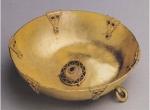 full resolution
full resolution
Fig. 1. Gold cup, Hungarian National Museum in Budapest (from W. Seipel 1999).
-
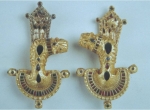 full resolution
full resolution
Fig. 2. Pair of matching lion brooches, Hungarian National Museum in Budapest (from W. Seipel 1999).
-
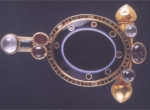 full resolution
full resolution
Fig. 3. Imperial brooch with onyx, Hungarian National Museum in Budapest (from W. Seipel 1999).
-
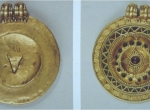 full resolution
full resolution
Fig. 4. Round pendant, Kunsthistorisches Museum, Vienna (from W. Seipel 1999).
-
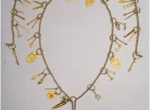 full resolution
full resolution
Fig. 5. Necklace, Kunsthistorisches Museum, Vienna (from W. Seipel 1999).
-
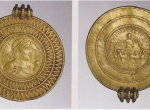 full resolution
full resolution
Fig. 6. Medallion of Valens struck in Rome in 376, Kunsthistorisches Museum, Vienna (from W. Seipel 1999).
-
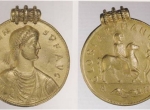 full resolution
full resolution
Fig. 7. Imitation Valens medallion, Kunsthistorisches Museum, Vienna (from W. Seipel 1999).


